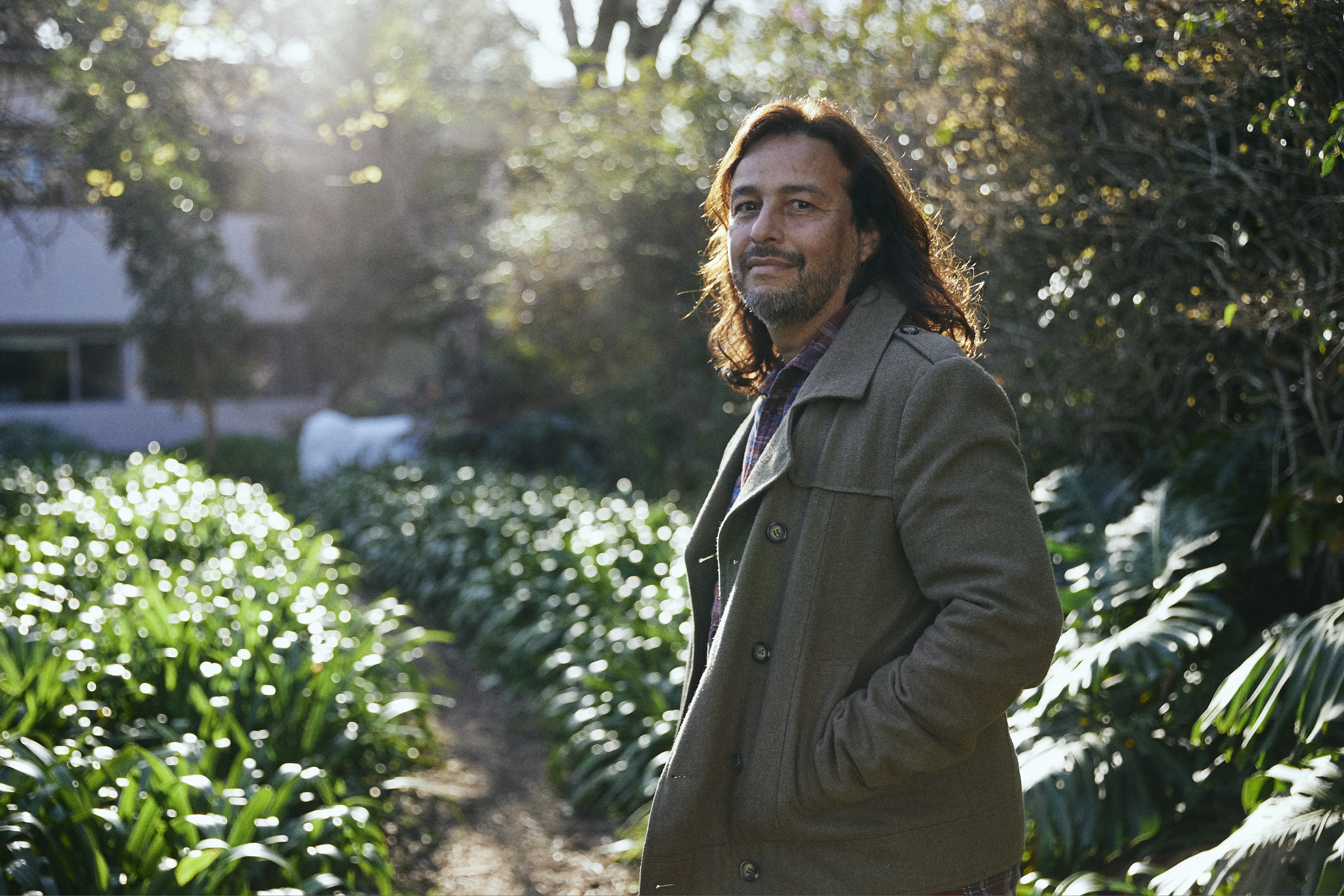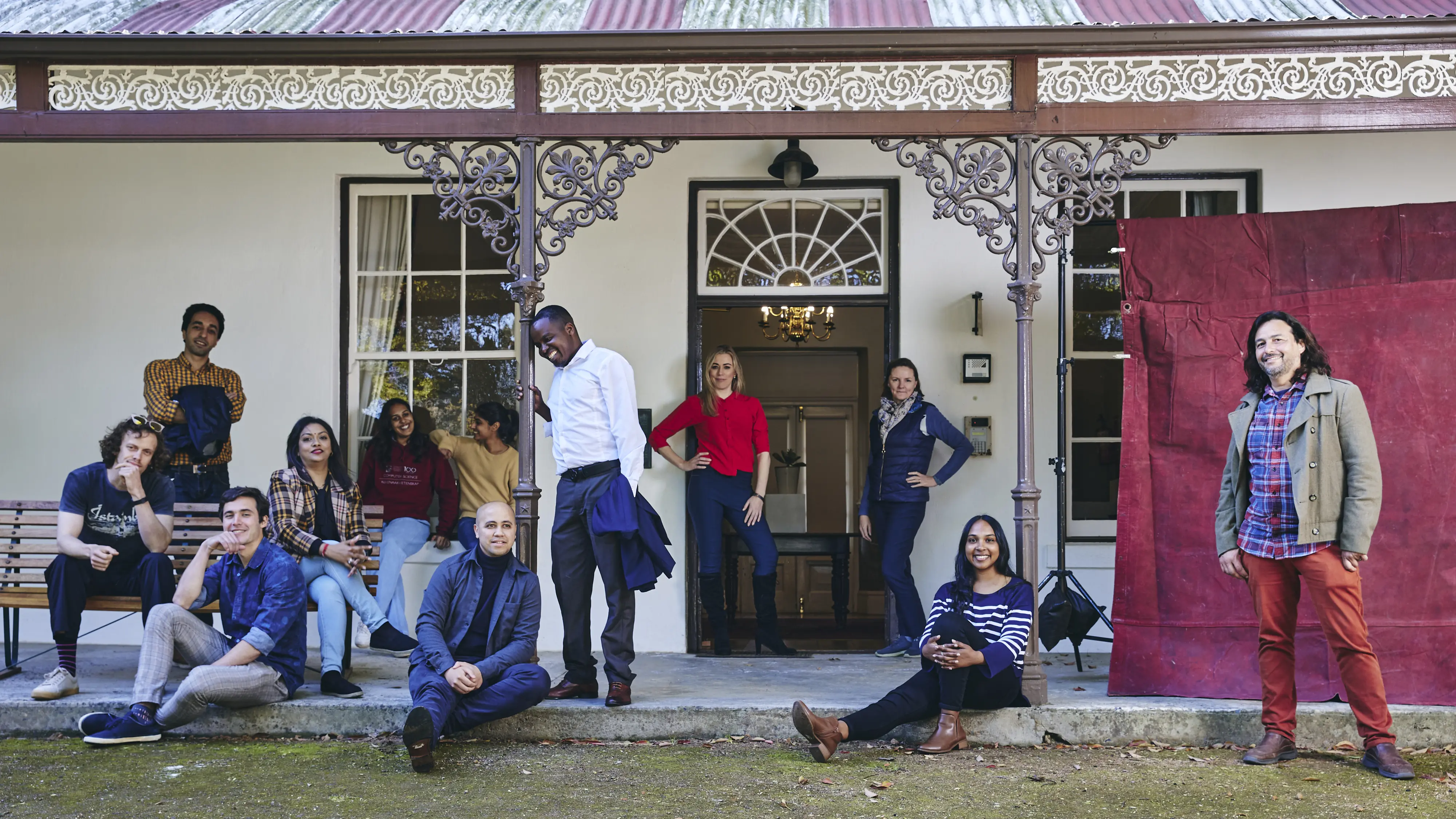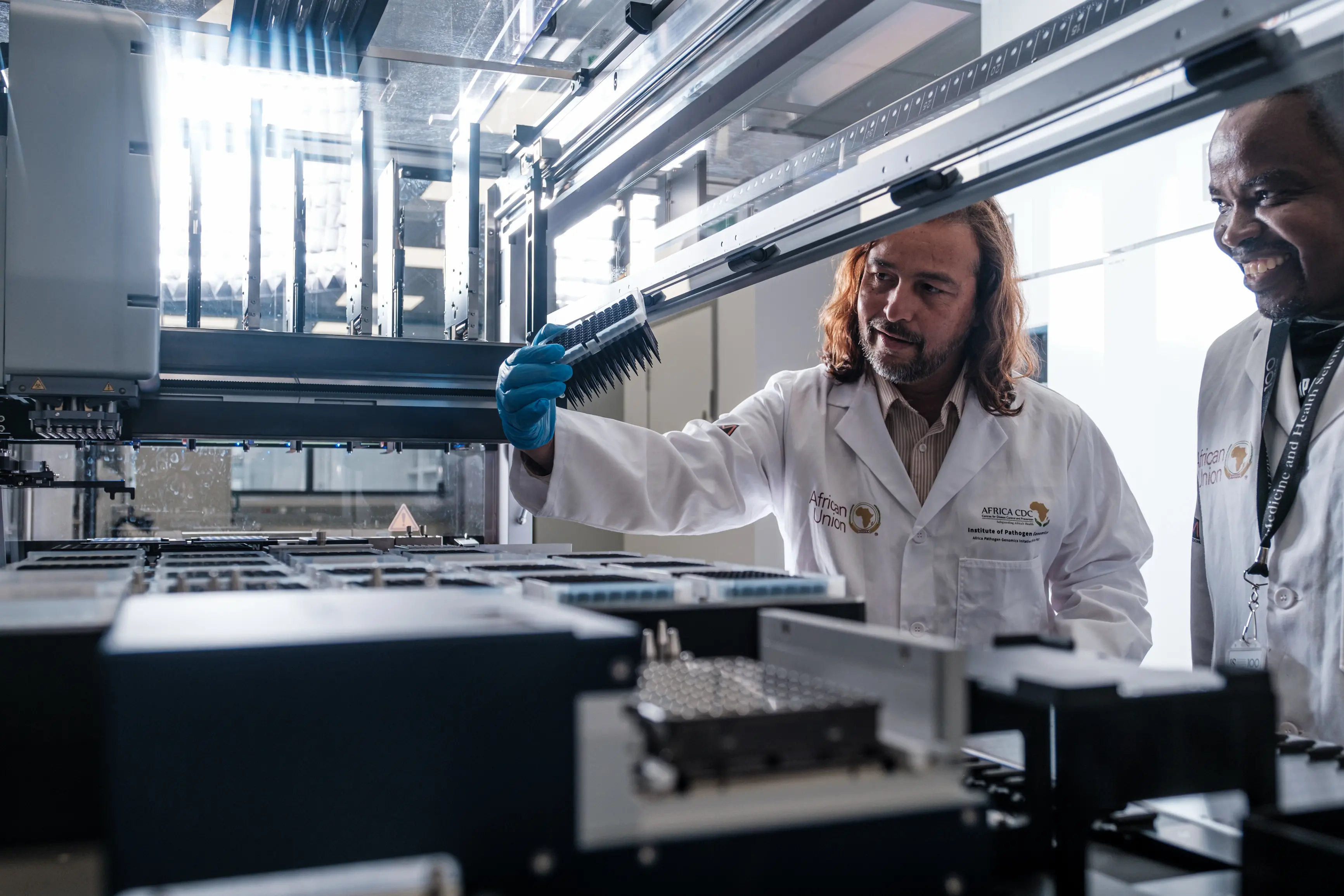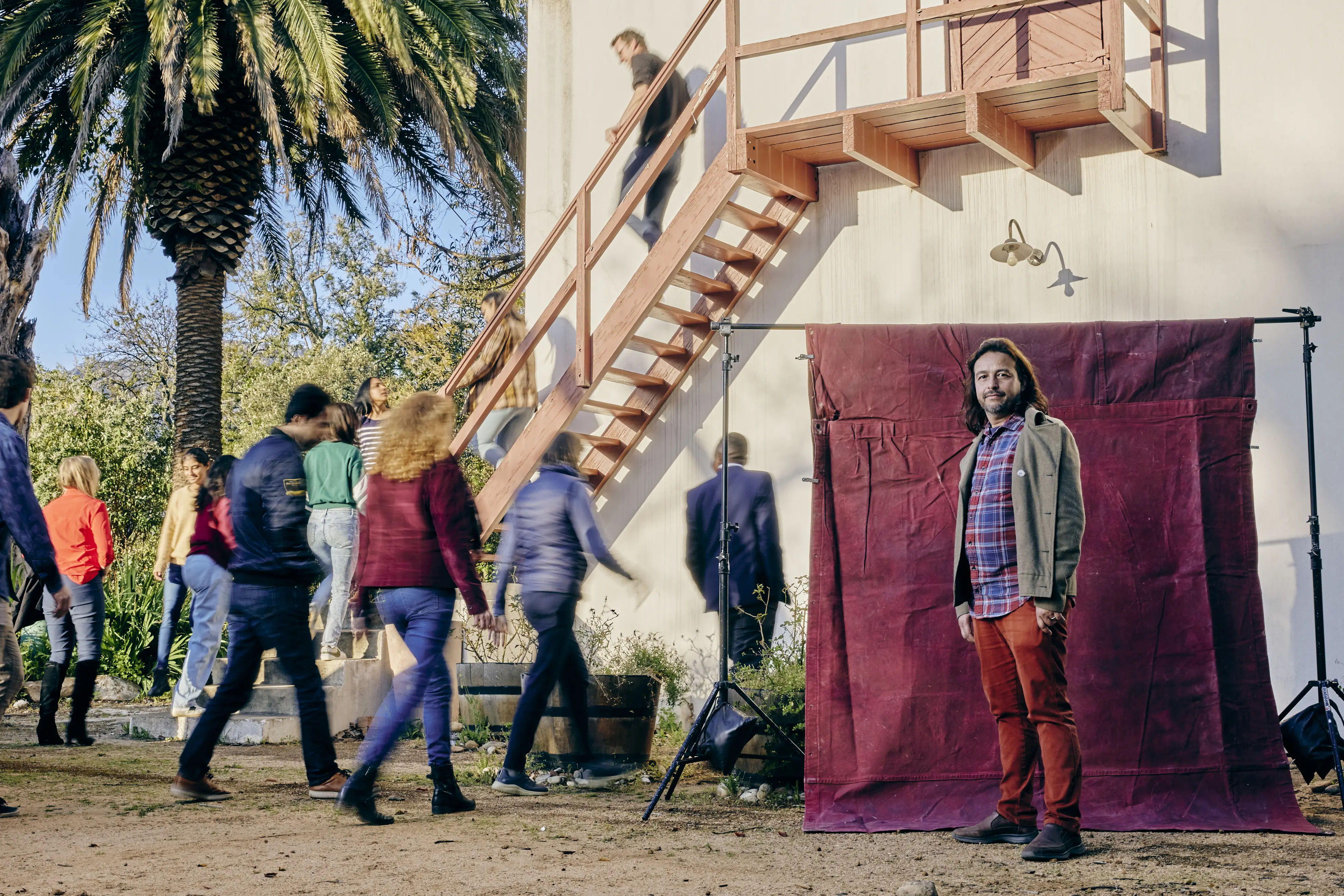
With rigorous science and good-humored braggadocio, Tulio de Oliveira champions coronavirus research from the Global South
This story was supported by the Pulitzer Center.
As Americans began to stir in the early morning hours of Thanksgiving Day 2021, a rapt international press corps was listening as a pony-tailed scientist in South Africa announced the identification of a worrisome new SARS-CoV-2 variant. Tulio de Oliveira, a Brazilian-born bioinformatician, explained that many of the variant’s dozens of mutations might make it more immune evasive and contagious—and that it was spreading “very fast” in South Africa.
“We really would like to be wrong on some of the predictions,” a sober de Oliveira told reporters. “The only thing that is any good […] is that we detected [it] very, very early […] [thanks to] the work of a truly big network.”
The next day, the World Health Organization (WHO) dubbed the new strain Omicron and classified it as a variant of concern. That same day, the United Kingdom and European Union banned travelers from South Africa, triggering 1.5 million cancellations in the country’s $5.5 billion tourism industry in 48 hours. De Oliveira promptly took to Twitter, calling the bans “evil” and “stupid,” adding that the United Kingdom should pay South Africa economic compensation.
De Oliveira, 46, of Stellenbosch University, has shot to prominence by delivering both vital insights about the shape-shifting coronavirus—and some sharp words for the Global North. Despite his ready smile and good humor in person, on Twitter and elsewhere he complains about countries that hog vaccines, unfairly impose travel bans, and practice what he calls colonial science. “Researchers in Africa have to produce at least twice as much to get less than half the respect of researchers from high-income countries,” he wrote recently in a stinging Lancet editorial. He also uses his platform to cheerfully promote the work of scientists from the Global South, including that of his own team. “The African Science Dream Team Strikes Again,” he tweeted last month, boasting about a new Science paper, which included more than 300 African co-authors and used 100,000 genomes to trace the evolution and spread of the pandemic coronavirus in Africa.
De Oliveira “speaks out against scientific inequity, especially when it comes to Africa. He’s an important voice for […] data credit—and not having this type of helicopter science where data comes from African countries and is published by European institutions,” says Emma Hodcroft, a molecular epidemiologist at the University of Bern. (She spent a few weeks on a fellowship in de Oliveira’s lab in 2016.)
De Oliveira’s provocative comments have angered some in the Global North, but his coronavirus sequencing work, which has repeatedly provided early warnings about menacing new strains, has won him high-profile fans. “The world owes Dr. Tulio de Oliveira a debt of gratitude for his genomic sequencing work […] and for sharing his research,” says WHO Director-General Tedros Adhanom Ghebreyesus.
“If Tulio wasn’t a practicing scientist, the world would have been slower to know about and understand emerging variants,” adds bioinformatician Trevor Bedford of the Fred Hutchinson Cancer Center. Time magazine put de Oliveira on its list of the 100 most influential people of this year and Nature named him as one of 10 researchers who shaped science in 2021.
Some scientists note the irony that an olive-skinned Brazilian has become a leading voice for African science. But others see no problem. “He is identified with Africa, and I think we are identified with him, regardless of his color,” says Sikhulile Moyo, lab director at the Botswana Harvard AIDS Institute Partnership in Gaborone. Moyo’s lab was the first to sequence Omicron and he shared Time’s accolade with de Oliveira. “He’s raising a lot of Black African scientists.”
"My message to the Global North is that … we need to be given the chance to lead."
Tulio de Oliveira, Stellenbosch University
De Oliveira is intent on keeping the conversation going: “My message to the Global North […] is that we are here,” he says. “If you realize that we have resources, experience, and knowledge […] we can help the whole world to avoid epidemics and pandemics. But we need to be supported and respected. We need to be given the chance to lead.”
DE OLIVEIRA COMES BY his activism honestly. His mother, international development consultant Maria João Nazareth, was born in Mozambique but spent her young adulthood in Brazil, where she was jailed several times—including when she was pregnant with Tulio—for protesting restrictions imposed by the military dictatorship then in power. Once, as an architecture student in Brasília, she organized a takeover of an anatomy lab to protest not being allowed to draw live nudes. (The students sketched cadavers instead.)
De Oliveira’s father, Nei Simas Andrade de Oliveira, a transportation engineer, was no less a rebel, with books by Che Guevara in his massive library. His parents split when Tulio was 11. His father was “a very sweet man, that despite [the fact] he got married five times and had like, six children, no one could get cross with him, including all his ex-wives and children,” de Oliveira recalls. His parents produced a crop of activists: Tulio de Oliveira’s siblings include a human rights lawyer in East Timor and a manager for a global human rights group.
João recalls her son as a magnet for friends—a kid who once led a throng of fellow skateboarders in a takeover of a major city street, shutting down traffic. He also started coding at age 11.

In college in Brazil, he majored in molecular biology but also dove into scientific computing. In 1997, when his mother returned to Africa, he went, too, finishing his undergraduate degree at the University of KwaZulu-Natal (UKZN), Durban. There, as an intern, he began to produce genomic sequences of a virus then laying siege to South Africa: HIV. In the process, he says, “[It] became quite clear that my laboratory skills were not fantastic.”
So he earned a Ph.D. at UKZN in bioinformatics: the art of using computers to analyze genomic sequence data. After graduating, he joined what he says was “the best viral evolution research group in the world” at the University of Oxford, working under Edward Holmes, now at the University of Sydney. He learned the real-world power of tracking viral evolution: When foreign medical workers were accused of deliberately infecting children in a Libyan hospital with HIV and hepatitis C, he and colleagues sequenced the viruses. The analysis showed the strains had been established in the hospital well before the medics arrived. The resulting Nature paper and a flurry of diplomacy saved their lives.
By 2009, de Oliveira was back in South Africa as director of what was then the Wellcome Trust Africa Centre’s genomics program in the rural village of Somkhele. There, among people with some of the highest HIV burdens in the world, he and colleagues conducted a large, landmark sequencing study showing older men were infecting younger women, a revelation that influenced control strategies in South Africa and elsewhere.
After a new director from the United Kingdom took over in 2013, de Oliveira chafed under what he felt was too much control of his work, which was separately supported by UKZN. In 2016, he moved with his South African wife and their young family to Durban, the site of UKZN’s medical campus. The next year, with government funding, he launched the KwaZulu-Natal Research Innovation and Sequencing Platform (KRISP). He was determined it would analyze genomes as fast and as well as any leading global genomics institute.
"My dream is to show the world that the Global south [..] [is] the best place in the world to identify new pathogens."
Tulio de Oliveira, Stellenbosch University
With Brazilian scientists, the center used viral sequences to track chikungunya and Zika outbreaks; it also documented growing HIV drug resistance. In its first 2 years, its scientists landed papers in Science, Nature, and dozens of other journals.
As well as dissecting outbreaks, de Oliveira was at pains to make it easier and cheaper for others to do so. He had already published lab methods for HIV drug-resistance monitoring in low-income settings and developed a software tool that automated HIV subtyping, making it far easier for researchers to sort through masses of genomic data. At KRISP, he and his team cranked out similar tools with names like Genome Detective that identified disease-causing viruses quickly and accurately from sequencing data without hours of painstaking work for the user.
De Oliveira was also set on training Africans and reversing the scientific brain drain that he saw drawing top young African talent to train in rich-world laboratories—from which many didn’t return. To date, he has trained scientists from 39 African countries, he says. Over the past decade, he estimates he and Richard Lessells, an infectious disease physician at UKZN, have also trained “easily between 5000 to 10,000 medical doctors and nurses” to use pathogen sequencing to understand outbreaks and apply targeted treatment.
“We have this very good relationship with most of the clinicians and nurses in the country,” de Oliveira says. When a worldwide pandemic descended, those relationships turned out to be crucial.
WITH HIS DEEP EXPERIENCE analyzing pathogen evolution, de Oliveira understood from the first days of the pandemic that genomic surveillance of SARS-CoV-2 would be vital. In early April 2020, 1 month after South Africa’s first coronavirus case was identified, he and colleagues began to investigate a SARS-CoV-2 outbreak at a Durban hospital. De Oliveira, Lessells, and Yunus Moosa, head of infectious diseases at UKZN, used gumshoe epidemiology and KRISP sequencers to find that a single patient had likely introduced the virus to the hospital, and that movement of patients between wards had probably hastened its spread; 15 patients died.
The team streamlined lab processes and soon published protocols for speedily sequencing the new virus. They also found that the viral genomes had a common, European ancestor and that the hospital’s first two cases were in people who had recently traveled to Europe.
De Oliveira and Lessells began advising the physicians and nurses in their network on spacing beds and separating patients. Their 37-page report on the outbreak quickly became a manual for hospitals the world over on how to prevent the spread of SARS-CoV-2; in the days following its release, it was accessed more than 10,000 times in 168 countries.
The team was eager to track SARS-CoV-2 evolution in all of South Africa. But it needed partners and funding. De Oliveira wooed South Africa’s National Institute for Communicable Diseases (NICD) by “showering them with kindness,” he says, sending scientists at the public health agency his new protocol along with $50,000 worth of needed reagents.

By May 2020, de Oliveira had won government funding, having corralled nearly a dozen partners, including NICD, national public health labs, and university groups into a sprawling surveillance consortium. While other countries lagged—the U.S. government didn’t significantly fund SARS-CoV-2 sequencing until early 2021—de Oliveira had already put his team in place. It vaulted the country to global prominence when SARS-CoV-2 began to shape-shift.
“He set it in motion,” says Anne von Gottberg, a clinical microbiologist at NICD, South Africa’s equivalent of the U.S. Centers for Disease Control and Prevention. “He got the first tranche of funding and he generously and magnanimously shared his expertise […] and shared reagents and standard operating procedures. [And the teamwork] really was what made [it] so tremendously powerful.”
Still, von Gottberg and others wryly note that de Oliveira’s outsize media profile can overshadow the work of dozens of scientists. “He shouldn’t be the only spokesperson. There are many of us […] working very hard in the background,” von Gottberg says.
De Oliveira himself stresses the teamwork behind his success. “Scientists like fighting,” he says, laughing. “The whole secret is that we manage […] to put all the scientists together in the country. I have enormous patience to make people work together.”
In mid-October 2020, hospitals in the Eastern Cape province saw an unexpected up-surge in SARS-CoV-2 cases and shipped swab samples from patients overnight, on ice, to the KRISP team. They spotted what looked like a new variant and notified others in the network, who increased sampling in the region. By December, the team confirmed the identity of what WHO later named the Beta variant. In Nature, de Oliveira’s network described the new mutations in the virus’ spike protein that, researchers later showed, made Beta deadlier than the original virus.
Within days of the Beta announcement, the U.K. government, already awash in a highly contagious home-grown variant, Alpha, identified two cases of Beta on U.K. shores. Then–U.K. health minister Matt Hancock called himself “incredibly grateful” to the South Africans for their transparency. Then he pronounced himself “incredibly worried” about Beta and banned travelers from South Africa—for 291 days.
De Oliveira promptly took to Twitter. “One release[s] results & is punished?” he asked.
It was a preview of what happened 11 months later, when South Africa again warned the world, this time about Omicron. Scientists again praised the country for its openness, but countries including the United Kingdom reimposed travel bans, despite WHO’s opposition on economic grounds. De Oliveira and colleagues began to field death threats from South Africans infuriated that scientists had gone public about Omicron and tripped off another round of punishing restrictions.
Today, Omicron has spread worldwide; the variant and its spinoffs—two of them, BA.4 and BA.5, also first described by de Oliveira’s team—now account for an estimated 42% of the coronavirus cases sequenced globally since the pandemic began, as well as untold millions of deaths. But Omicron might have done still more damage if the South Africans hadn’t alerted the world so quickly, giving other countries time to prepare.
That’s why travel bans are more than unjust, de Oliveira says. They “are a massive problem for global health,” he says, a disincentive for scientists to publicize new variants. “They may choose to keep quiet so they are not punished. And that could easily cause new epidemics and pandemics.”
DE OLIVEIRA’S RHETORIC can have a bitter edge. This spring, he lashed out at Tom Wenseleers, an evolutionary biologist at KU Leuven, for putting his own name at the bottom of Twitter graphs created with data from the database GISAID and South Africa’s NICD. (When he tweeted the graphs, Wenseleers did credit both sources.) “Some global north scientists wait for ‘free data’ to analyze and even put their names on the graphs! Shame @TWenseleers,” de Oliveira tweeted.
Minutes before de Oliveira’s tweet, Wenseleers apologized on Twitter, calling himself remiss in not more directly crediting “the incredible work” of de Oliveira and others in South Africa in generating sequence data; de Oliveira himself later apologized for his angry tweet. But Wenseleers also bristled at de Oliveira’s charge of scientific colonialism, and the pair continue to spar on Twitter.
Similarly, when de Oliveira tweeted in July complaining that pandemic prevention institutes were being established “in Seattle, Washington, Berlin, Geneva and not in South Africa, Brazil, India, Indonesia,” Dutch virologist Marion Koopmans of Erasmus University Medical Center shot back: “The North versus South narrative does not help. […] We should collaborate, not polarize.”
Deepti Gurdasani, a statistical geneticist at Queen Mary University of London, has used Twitter to flag excess deaths from Omicron subvariants in South Africa. That annoyed de Oliveira, who contends other respiratory viruses have fed into the excess deaths and that recent Omicron subvariants were less severe than the original. Gurdasani charges that de Oliveira “seems to […] troll and bully researchers” who counter a narrative that Omicron is relatively benign. “That, to me, has been really, really disappointing,” Gurdasani says.
“The tone of my Twitter is sometimes harsh,” de Oliveira concedes. “But the […] scientific discrimination, the economic damage from travel bans, the hoarding of vaccines that we suffer[ed] in South Africa during this pandemic was much, much harsher.”
De Oliveira has used his ever-increasing visibility to advocate for the Global South on other issues. In June, he and genomicist Christian Happi of Redeemer’s University in Nigeria organized a letter signed by 29 scientists, most of them African, protesting a stigmatizing Africa-specific monkeypox naming scheme and calling for a new nomenclature. Days later, WHO announced it would abandon the “Congo Basin” and “West Africa” monkeypox clade names.
It helps that de Oliveira can bend ears at the highest levels. “Thank you Tulio. Good to hear from you,” Tedros texted to him during the monkeypox lobbying campaign. “I will get back to you ASAP.”
“Tulio [is] becoming a voice for Africa,” says his senior grants manager, Suzette Grobler. She has worked with him since he was what she calls a rule-breaking “wild child” who once absconded to Brazil with an Africa Centre–owned laptop. (She browbeat him into sending it back.) “Life has just afforded him the opportunity right now that people want to talk to him and want to hear what he has to say.”
"My mother was a freedom fighter. My father was also very rebellious. My whole family [has tried] to help decrease suffering in poor countries."
Tulio de Oliveira, Stellenbosch University
“He is the only scientist I think I know in Africa who is very vocal, who says the truth always,” says Lucious Chabuka, a laboratory technician at the Public Health Institute of Malawi and a master’s student and fellow at de Oliveira’s new institute, the Centre for Epidemic Response and Innovation (CERI).
Chabuka and others say that when speaking to junior scientists, de Oliveira demonstrates the respectful attitude he demands from others. “I was really impressed. […] He lets people contribute,” says Fortunate Natwijuka, a laboratory technologist at the Uganda Virus Research Institute who attended a freewheeling session in “meeting room 1”—a table and lawn chairs under the trees outside the renovated winery that serves as CERI’s administrative headquarters. When a colleague introduced her to de Oliveira, she says she was surprised by his relative youth and said, “I didn’t realize this was your professor!” Tulio responded, “‘Don’t worry about the professor—I’m Tulio,’” she recalls.

De Oliveira, whose idea of dressing up for visitors consists of adding a rumpled jacket to his chinos and well-worn loafers, appears unconcerned with status. “We always chat. […] You can ask him anything,” says Onke Tsewu, the security guard at the building that houses CERI. “He is the sweetest, coolest guy I have ever known.”
EVEN BEFORE HIS NETWORK identified Omicron, de Oliveira’s sequencing prowess was drawing job offers at home and abroad. In July 2021, he accepted one from Stellenbosch University to launch the new genomics center, CERI, which has labs in a newly refurbished $100 million university research building in Cape Town. CERI’s staff of 20 is expected to double in the next year; it also plays host to a steady stream of visiting fellows from other African countries. And it has powerful backers: In its first year it landed grants and donations worth $18 million from groups including the World Bank, the Rockefeller Foundation, the European Commission, the Abbott Pandemic Defense Coalition, and the U.S. National Institutes of Health.
At UKZN’s request, de Oliveira continues to run KRISP, making the 140-minute flight to Durban frequently. For now, he himself has no office at CERI, though he’ll have one when the building is complete early next year. “To sit in a big office and feel very self-important—I have no patience for that,” he says. “Then you get away from the science.”
Recently, de Oliveira gave a tour of CERI to a group of German politicians, part of a parade of dignitaries who regularly visit. He showed off a Goldilocks set of sequencers crowned by two million-dollar Illumina machines and including three 11-kilogram Oxford Nanopore sequencers useful for training visiting fellows who will use similar machines back in their own countries.
In a practiced stream of genial talk, de Oliveira noted the two biggest sequencers, donated by the Chan Soon-Shiong Family Foundation, give the institute the most sequencing horsepower in Africa, making it a sentinel for future pandemics. One politician leaned in for a selfie with de Oliveira, who smiled obligingly and told the group, “I have received thousands of journalists, many from Germany—all the main TV channels. They come and say, ‘Oh, were you surprised that South Africa did so well on the scientific response to COVID?’ And I say—‘No!’”
After the Germans left, he laughed at himself. “I’m good at selling CERI. That’s important. That’s my job.”
De Oliveira plans to merge CERI with KRISP soon, but his long-term ambitions are bigger. He envisions multiple campuses in several African countries, delivering hundreds of opportunities for budding local scientists and forcing the world to contend with Africa as a scientific power. “My dream is to show the world that the global South—Africa, Latin America, and Southeast Asia—are the best place in the world to identify new pathogens and control them.”





